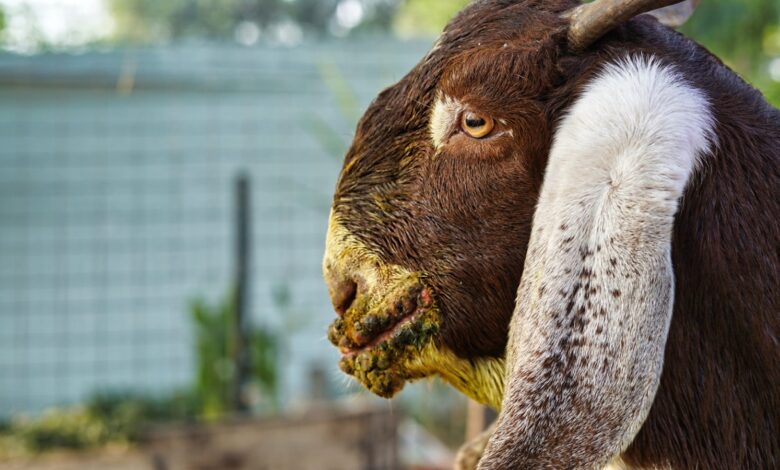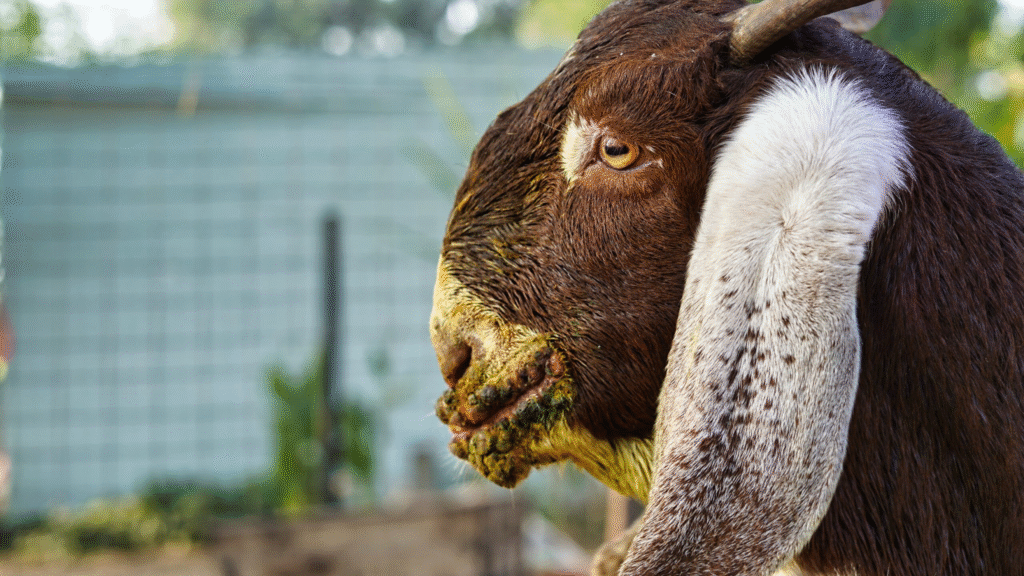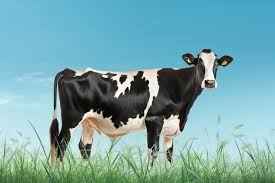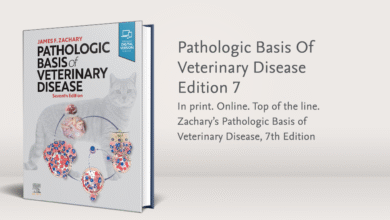Current status of contagious ecthyma or (orf disease) in goat and sheep
🦠 What is Contagious Ecthyma (Orf Disease)? 🌍 Global Prevalence and Endemic Regions 🐐 Clinical Signs in Goats and Sheep 🧪 Diagnosis: How is Orf Disease Identified? 🩺 Treatment Options and Supportive Care 🛡️ Preventive Measures and Vaccination Strategies ⚠️ Zoonotic Risk: Can Humans Get Infected? 📉 Economic Impact on Livestock Farming 📰 Recent Outbreak Reports and Research Findings ✅ Best Practices for Farmers and Veterinarians 🔚 Conclusion: Managing and Monitoring Orf Disease

Abstract
Contagious ecthyma, an acute, contagious, debilitating and economically important viral skin disease of sheep, goat and some other domesticated and wild ruminants is worldwide in distribution. It is a nonsystematic eruptive skin disease having public health importance. The disease is also known as sore mouth, contagious pustular dermatitis or scabby mouth. It is usually more severe in goats than in sheep and characterized by proliferative lesions on the mouth and muzzle usually resolved in 1–2 months. Other important members of the genus are Abstract
Contagious ecthyma, an acute, contagious, debilitating and economically important viral skin disease of sheep, goat and some other domesticated and wild ruminants is worldwide in distribution. It is a nonsystematic eruptive skin disease having public health importance. The disease is also known as sore mouth, contagious pustular dermatitis or scabby mouth. It is usually more severe in goats than in sheep and characterized by proliferative lesions on the mouth and muzzle usually resolved in 1–2 months. Other important members of the genus are Abstract
Contagious ecthyma, an acute, contagious, debilitating and economically important viral skin disease of sheep, goat and some other domesticated and wild ruminants is worldwide in distribution. It is a nonsystematic eruptive skin disease having public health importance. The disease is also known as sore mouth, contagious pustular dermatitis or scabby mouth. It is usually more severe in goats than in sheep and characterized by proliferative lesions on the mouth and muzzle usually resolved in 1–2 months. Other important members of the genus are pseudocowpox virus and bovine papular stomatitis virus . Although clinical signs are indicative of the orf disease, a laboratory based diagnosis is necessary for confirmation and epidemiological investigations. The lesions of the disease often jeopardize the optimum productivity and reduce the market value of the meat, leather and wool besides disruption of the national and international trade of animal and animal products. Further, the zoonotic importance of the disease has added the significance of the disease to a new dimension. and bovine papular stomatitis virus. Although clinical signs are indicative of the orf disease, a laboratory based diagnosis is necessary for confirmation and epidemiological investigations. The lesions of the disease often jeopardize the optimum productivity and reduce the market value of the meat, and wool besides disruption of the national and international trade of animal and animal products. Further, the zoonotic importance of the disease has added the significance of the disease to a new dimension.and bovine papular stomatitis viruus . Although clinical signs are indicative of the orf disease, a laboratory based diagnosis is necessary for confirmation and epidemiological investigations. The lesions of the disease often jeopardize the optimum productivity and reduce the market value of the meat, leather and wool besides disruption of the national and international trade of animal and animal products.
Further, the zoonotic importance of the disease has added the significance of the disease to a new dimension.on isolation, identification, physico-chemical properties, host range, pathogenesis, epidemiology, clinical signs, pathology, diagnosis, treatment, immunity and prophylaxis in goats and humans would not only help in updating the knowledge of scientific fraternity but also would be useful to the policy makers in order to formulate appropriate measures for control and eradication of the disease. This review is aimed to present the latest information on the disease to the readers that in turn help in the effective and efficient management of the disease leading the reduction of the economic losses to a great extent.
Introduction
Contagious ecthyma is an acute, contagious, debilitating and economically important zoonotic viral skin disease that affects sheep, goat and some other domesticated and wild ruminants. It is a nonsystematic eruptive skin disease having worldwide in distribution. The disease is also known as sore mouth, contagious pustular dermatitis or scabby mouth (Thomas et al., 2003) and it is usually more severe in goats than in sheep. The disease is manifested by proliferative lesions on the mouth and muzzle that usually resolved in 1–2 months (McKeever et al., 1988). Primary orf lesions are the most severe with a clinical progression of erythematous macule, papule, vesicle, pustule and scab formation in 4–6 weeks and young animals are at high risk. Severe facial and oral lesions in lambs may interfere with suckling, lesions on the udder may result in the abandonment of offspring and foot lesions can cause transient lameness. Reinfection lesions progress through the same clinical stages but are generally smaller, not proliferative and resolve more rapidly usually within 2–3 weeks. Orf is not normally fatal but is a debilitating disease that can be fatal if lambs and kids are prevented from suckling or succumb to secondary bacterial or fungal infections (Haig and McInnes, 2002). The morbidity of the disease may reach up to 100% and mortality due to secondary bacterial infections may reach to 15% (Gumbrell and McGregor, 1997). Zoonoses occur most frequently during lambing, shearing, docking, drenching or slaughtering of affected animals. Most infections in humans are localized and heal spontaneously. However, large poorly healing lesions are usually seen in immunosuppressive individuals. This communication presents an up-to-date comprehensive review on current status, latest developments, future prospects of orf disease and its control.

Section snippets
Etiology
Orf virus is under the genus Parapoxvirus and family Poxviridae. Other members of the same genus are bovine papular stomatitis (BPS) virus, parapoxvirus of red deer in New Zealand (PVNZ), pseudocowpox virus (PCPV) as well as three tentative species of the genus, auzdyk disease virus, chamois contagious ecthyma and seal pox virus (Buchen Osmond, 2003). The parapoxviruses are antigenically and genetically related and have similar morphology, genomic organization and virulence mechanism (Fleming
Physico-chemical properties
Parapoxviruses like capripox and leporipox are ether sensitive whereas, orthopoxviruses and avipoxviruses are ether resistant. The parapoxvirus is quite resistant and survives for several months in a cool and dry environment but is destroyed by high and very low temperatures, UV light and wetting (McKeever and Reid, 1986). The virus resists physical damage and persists through the winter months on hedges feeding, troughs and barns. It can be inactivated at 60 °C in 30 min. Orf virus on shaded
Host range
Contagious ecthyma occurs in sheep, goats, cattle, alpacas, camels, reindeer, big horn sheep, Sichuan takin, domestic Shetland sheep, deer, prong horn antelope, wapiti and seal squirrels (Oksanen and Norberg, 1994, Robinson and Mercer, 1995, Azwai et al., 1995, Thomas et al., 2003, Guo et al., 2004, Tryland et al., 2005). Boer goats are highly susceptible to orf virus infection and exhibit severe lesions (Ndikuwera et al., 1992).

Epidemiology
Contagious ecthyma is found worldwide and is more common in late summer, fall and winter on pasture and in feedlots. Lambs and kids are more susceptible to disease than adults. Orf virus is robust in a dry environment and can survive for months or even years, but its lifespan may be shorter in cold and wet conditions. The virus remains viable on the wool of recovered animals for substantial periods. Orf virus enters via broken, scarified or otherwise damaged skin and replicates in epidermal…
Pathogenesis
Skin is the main site of predilection and essential for establishment and development of lesions. Initially virus replicates in the epidermal cell layers derived from the walls of wool follicle. At the time of grazing, the dried stemmy and spiny feed may abrade the tissues of lips, nostrils, mouth as well as fore stomach. Through such abrasions virus penetrates the skin of mucosa and leads to formation of acanthosis, ballooning degeneration of spinose cells, hyperplasia of basal cells and
Host response to orf virus infection
The quality and intensity of orf virus infection depends on dynamics of immune response cells, antibodies and cytokine activity. Host immune response is very much important for controlling the magnitude of orf virus multiplication. Orf virus infected sheep produce antibodies against five immunodominant antigens. The monoclonal antibodies recognize the 39 kDa and 42 kDa of envelope protein, 10 kDa putative fusion protein and uncharacterized 22 kDa and 65 kDa proteins. These antigens are extremely…

Virus virulence factors and evasion of host immunity
It has been observed that orf virus often repeatedly infects and replicates in sheep in spite of recovery from primary attack. There are several possible reasons behind this phenomenon. Firstly, the virus infects epidermal cells and undergoes limited replication before host anti-viral effector molecules reach the infection site. Secondly, by targeting regenerating epidermal cells, the virus is less likely to stimulate apoptosis in the cells. Finally, virus possesses mechanisms to interfere with
Clinical signs and symptoms
The incubation period of the disease varies from 4 to 8 days with an initial rise in temperature, development of papules and pustules often at oral commissures, skin of lips and nose followed by thick, tenacious scabs covering a raised area of ulceration, granulation and inflammation. Similar skin lesions of few millimeters to several centimeters are also seen in the lips of the kids particularly below two months of age and disseminated to the skin of face, ears, feet, flanks, and scrotum.

Pathology and serum biochemistry
Numerous multifocal to coalescing, broad based, hairless, greasy, malodorous, ulcerated and papillary nodules are characteristic of skin lesions. Granulomatous lesions are also formed during regression. At necropsy of malignant form of orf, irregular shaped lesions with congestion of oral cavity and respiratory tract are revealed. In some cases, necrotic foci and ulcers may be found on tongue, gum, pharynx, rumen and abomasums because of secondary infection. Sometimes liver abscesses are also
Diagnosis
The contagious ecthyma can be diagnosed on the basis of characteristic lesions on the anatomic areas of predilection. It should be differentially diagnosed from sheep pox, foot and mouth disease (FMD), staphylococcal dermatitis, dermatophilosis and ulcerative dermatosis. The oral lesions due to FMD in sheep are most likely to develop at sites vulnerable to trauma such as dental pad, upper and lower gums, and the tongue, however, the main clinical features…
Therapeutic management
During outbreak of contagious ecthyma in flocks or herds, quarantine of new animals before introducing to the new herd is very important. Sick animals should be separated, fed and treated after feeding the herd. Consumption of milk from does that present lesions on the teats and udder should be avoided. Gloves and facemasks should be used at the time of handling sick animals and vaccination as humans can contract the disease.
Treatment
Orf disease (also known as contagious ecthyma, sore mouth, or scabby mouth) is a highly contagious viral skin disease affecting sheep and goats, caused by the Orf virus, a member of the Parapoxvirus genus.
Overview
| Feature | Details |
|---|---|
| Cause | Orf virus (Parapoxvirus) |
| Transmission | Direct contact with infected animals or contaminated surfaces |
| Zoonotic? | Yes – can infect humans (painful pustules on hands) |
| Common Signs | Papules, pustules, scabs on lips, gums, nostrils, udders, and feet |
Treatment of Orf in Sheep and Goats
There is no specific antiviral treatment. Supportive care and prevention of secondary infection are key.
1. Supportive Care
- Ensure animals continue eating — offer soft, palatable feed.
- Provide clean, comfortable housing.
- Isolate affected animals to prevent spread.
2. Topical Treatment
- Antibiotic ointments (e.g., tetracycline) on lesions to prevent bacterial infections.
- Clean lesions gently with mild antiseptics (e.g., iodine-based solutions) if necessary.
3. Systemic Antibiotics
- Only used if there’s a secondary bacterial infection (signs: swelling, pus, fever).
- Use under veterinary supervision.
4. Pain Relief (Optional)
- NSAIDs like meloxicam can be used under veterinary direction for pain and inflammation.
Vaccination
Orf or contagious ecthyma being a viral disease of sheep and goats with no suitable antiviral therapeutic schedule, vaccination is the only option for effective control of orf virus infection. Although various kinds of vaccines are available against orf disease, live attenuated vaccines are always considered superior to others and being used in some parts of the world where it is endemic.
Prevention
Although vaccination is the efficient and cost effective method of preventing the orf virus infections, zoo sanitary measures and disinfection practices should also be implemented along with it. The isolation of infected animals can help prevent the spread of the disease. The new animals should be quarantined before mixing with other animals of a farm to prevent the entry of the orf virus. Some apparently healthy carrier animals without any signs of the disease may spread the virus.
Public health importance
Contagious ecthyma is highly communicable and numerous cases of orf have been reported in humans from various parts of the world (Leavell et al., 1968, Dupre et al., 1978, Huerter et al., 1991, Bassioukas et al., 1993, Georgiades et al., 2005). The orf virus remains viable on the wool and hides for one month after the healing of wounds. Humans particularly shepherds, veterinarians, farmers’ wives who bottle feed young lambs as well as butchers and meat porters can acquire the infection from it.
Conclusion
Contagious ecthyma is an acute, highly contagious and economically important viral disease that affects skin of sheep, goat and some other domesticated and wild ruminants and having zoonotic importance. The most effective way for orf virus to enter into a new area is by introduction of infected animals. Restriction of movement of animals and their products are crucial to prevent introduction of orf disease. Animal products must be subjected to suitable decontamination procedures before entry.



